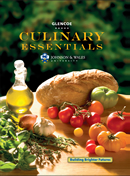
Culinary Essentials ©2010Chapter 26: Baking TechniquesCheck Your Answers: After You ReadSection 26.1Review Key Concepts1. To use a balance scale, you must first place the scale scoop on the left side of the scale. Compensate for the weight of the scoop by balancing the right side with weights. Then, add weights to the right side of the scale to equal the desired weight of ingredients. Finally, add the ingredient to the scoop on the left side of the scale until the scale is balanced.2. A proofing cabinet can be used to keep baked products warm or to proof yeast dough. It allows dough to rise slowly in a humidity controlled, low-heat environment before baking. 3. Pans used in a bakeshop include cake pans, spring form pans, tart pans, and sheet pans. Practice Culinary Academics4. English Language Arts The letter should provide specific information about the equipment needed and why it is necessary for making commercial cupcakes. Students should use proper grammar and spelling, and the letter should be written in a business letter format and tone.5. Mathematics The baker's percentages are as follows: Bread flour = 3 kg ÷ 4 kg = 0.75 = 75%. Rye flour = 1 kg ÷ 4 kg = 0.25 = 25%. Water = 2.8 kg ÷ 4 kg = 0.7 = 70%. Yeast = 0.08 kg ÷ 4 kg = 0.02 = 2%. Salt = 0.12 kg ÷ 4 kg = 0.03 = 3%. Total = 7 kg ÷ 4 kg = 1.75 = 175%. Section 26.2Review Key Concepts1. The most common types of fat used in a bakeshop are vegetable shortening, emulsified shortening, oil, butter, and margarine.2. Folding is gently adding light ingredients into heavier ingredients with a smooth circular movement, while kneading is working dough by hand or in a bench mixer with a dough hook to develop gluten and evenly distribute the ingredients. Practice Culinary Academics3. English Language Arts The dialogue should use language appropriate to a teacher and student and should provide accurate information from the chap ter about one type of common bakeshop ingredient. It should be written in a dialogue form, with the name of the speaker, followed by what they say.4. Science Answers may vary, but according to nutritiondata.com: 1 cup of unsweetened chocolate has around 660 calories, 69 g of fat, and 1 g sugar; 1 cup of semisweet chocolate has around 800 calories, 50 g of fat, and 92 g sugars; 1 cup of white chocolate has around 916 calories, 55 g fat, and 100 g sugars; 1 cup cocoa powder has around 197 calories, 12 g fat, and 2 g sugars; and in 1 cup of Dutch process cocoa powder is around 240 calories, 8 g fat, and 0 g sugar. 5. Mathematics Erica needs 16 cups of 1% milk and 8 cups of 4% milk. If x = cups of 1% milk and y = cups of 4% milk, then x + y = 24 cups, or x = 24 − y. We also know that 0.01x + 0.04y = (0.02)(24) = 0.48, or, multiplying both sides by 100 to remove the decimals, 1x + 4y = 48. Substituting (24 − y) for x in the second formula gives 24 − y + 4y = 48, or 3y = 48 − 24, or 3y = 24, or y = 8. Since x = 24 − y, then x = 24 − 8 = 16. |  |















